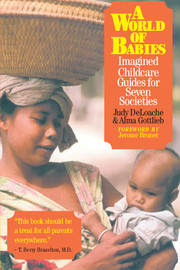Book contents
- Frontmatter
- Contents
- Foreword
- Editors’ Acknowledgments
- Note to the Reader
- CHAPTER ONE If Dr. Spock Were Burn in Bali: Raising a World of Babies
- CHAPTER TWO A Parenting Manual, with Words of Advice for Puritan Mothers
- CHAPTER THREE Luring Your Child into This Life: A Being Path for Infant Care
- CHAPTER FOUR Gift from the Gods: A Balinese Guide to Early Child Rearing
- CHAPTER FIVE Making Babies in a Turkish Village
- CHAPTER SIX Infants of the Dreaming: A Warlpiri Guide to Child Care
- CHAPTER SEVEN The View from, the Wuro: A Guide to Child Rearing for Fulani Parents
- CHAPTER EIGHT Never Leave Your Little due Alone: Raising an Ifaluk Child
- Note to Chapter One
- About the Contributors
- Authors' Acknowledgments
- Citations and Sources Cited
- Index
CHAPTER SIX - Infants of the Dreaming: A Warlpiri Guide to Child Care
Published online by Cambridge University Press: 05 September 2014
- Frontmatter
- Contents
- Foreword
- Editors’ Acknowledgments
- Note to the Reader
- CHAPTER ONE If Dr. Spock Were Burn in Bali: Raising a World of Babies
- CHAPTER TWO A Parenting Manual, with Words of Advice for Puritan Mothers
- CHAPTER THREE Luring Your Child into This Life: A Being Path for Infant Care
- CHAPTER FOUR Gift from the Gods: A Balinese Guide to Early Child Rearing
- CHAPTER FIVE Making Babies in a Turkish Village
- CHAPTER SIX Infants of the Dreaming: A Warlpiri Guide to Child Care
- CHAPTER SEVEN The View from, the Wuro: A Guide to Child Rearing for Fulani Parents
- CHAPTER EIGHT Never Leave Your Little due Alone: Raising an Ifaluk Child
- Note to Chapter One
- About the Contributors
- Authors' Acknowledgments
- Citations and Sources Cited
- Index
Summary
THE WARLPIRI OF AUSTRALIA
The Warlpiri people constitute one of at least 500 Aboriginal groups living in Australia. Although there has been much debate about Aboriginal history before European contact, it is known that Aborigines have been in Australia for at least 40,000 years and, according to recent archaeological findings, perhaps for as long as 120,000 to 180,000 years. Rock art and stone artifacts were produced at least 5,000 years ago.
When European settlers arrived in the eighteenth century, the Aboriginal population was estimated as at least 300,000. As of 1986, 228,000 Aborigines resided on the continent, constituting only 1.5 percent of the total population of 15 million. Today, the Warlpiri (sometimes spelled Walpiri or Walbiri) number approximately 2,500. They live primarily in settlements in the Central Desert of Australia's Northern Territory. The Warlpiri speak a distinctive language that belongs to the Pama Nyungan language group, but many Warlpiri also speak “Aboriginal English” as well as other Aboriginal languages.
The arrival of Europeans on the continent led to drastic changes in the lives of the resident Aborigines. Beginning in the early nineteenth and continuing into the twentieth century, the British forcibly took control of much of the native lands and established their own modes of agriculture, often ignoring Aboriginal ties to the land. Confrontations between settlers and native groups were often very violent: Thousands of Aborigines were Killed in massacres continuing into the 1930s.
- Type
- Chapter
- Information
- A World of BabiesImagined Childcare Guides for Seven Societies, pp. 145 - 170Publisher: Cambridge University PressPrint publication year: 2000
- 2
- Cited by



